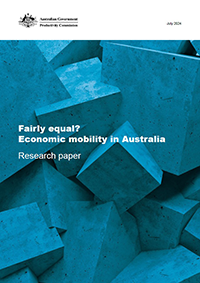Fairly equal? Economic mobility in Australia
Research paper
Released 10 / 07 / 2024
This research paper explores economic mobility – how inequality changes over time – by looking at whose incomes are increasing, and whose are not. It examines income changes over a person’s lifetime, and how incomes change from one generation to the next. It also explores the characteristics of people experiencing poverty.

Media release
Economic mobility – a ‘fair go’ for many but some left behind
New research from the Productivity Commission shows Australia performs well on income mobility. ‘For most Australians, the amount your parents earned when you were young is not a life sentence,’ said Chair Danielle Wood.
The report, Fairly equal? Economic mobility in Australia, finds that 67% of the so-called ‘Xennial’ generation – those born in 1976–1982, on the cusp of the Millennial/Gen X divide – earn more than their parents did at a similar age.
‘In Australia, a 10 percentile rise in a parent’s rank in the income distribution is linked to a relatively small 1.8 percentile rise in the child’s rank,’ said Commissioner Catherine de Fontenay.
‘This result places us near the top of the global rankings for income mobility between generations, alongside the Scandinavian countries.’
However, the report also finds that children with parents in the bottom or top of the income scale are more likely to remain there themselves. Almost 15% of people with parents in the bottom income decile remained in the bottom decile, while just 6% of them ended up in the top decile.
The report also notes that wealth tends to be ‘stickier’ than income, with people experiencing far lower levels of wealth mobility over their lifetimes. When income is adjusted to account for wealth, over 40% of people in the top or bottom two deciles in 2001 remained there in 2022.
‘On top of this, cost of living pressures and rising property prices mean higher earnings may not afford you the same standard of living and access to wealth as they have in the past,’ said Chair Danielle Wood. ‘We shouldn’t take the ‘fair go’ for granted.’
Australians living in poverty face some of the highest barriers to economic mobility.
‘Most Australians have had a good opportunity to climb the income ladder, but it’s a much harder climb for Australians living in poverty,’ said Commissioner de Fontenay.
Although interrupted by the pandemic, the poverty rate in Australia has slowly increased over recent years. About one in seven Australians experienced poverty in 2022 – the highest level since 2001.
How long poverty lasts matters as much as how many people it affects – about 10% of Australians experienced poverty in at least three of the five years between 2018 and 2022.
The report collects a trove of data on poverty risk factors, showing renters, people from migrant backgrounds who do not speak English at home and single parents are among the groups most at risk. Moreover, people who live in disadvantaged neighbourhoods, including those in remote locations, are more likely to remain in poverty over time.
‘Australia really has been the ‘land of the fair go’ for many, but we can’t ignore what’s happening for people in poverty. Policymakers should make sure support is targeted to where people need it most,’ said Ms Wood.
The report can be accessed from the Commission’s website at www.pc.gov.au.
Media requests
Media team – 02 6240 3330 / media@pc.gov.au
Contents
- Preliminaries: Cover, Copyright and publication detail, Contents and Acknowledgments
- Executive summary
- 1. Economic mobility: Why does it matter?
- 1.1 Factors that influence mobility
- 1.2 Why does mobility matter?
- 1.3 Is there a ‘right’ level of mobility?
- 2. Life course mobility
- 2.1 How do people’s economic positions change over their lives?
- 2.2 Education and income mobility over a lifetime
- 2.3 The impact of life events on income mobility
- 3. Intergenerational economic mobility
- 3.1 Are people earning more than their parents?
- 3.2 How much of people’s incomes are explained by what their parents earn?
- 4. Poverty and low mobility
- 4.1 How prevalent is poverty in Australia?
- 4.2 Who experiences poverty?
- 4.3 How persistent is poverty?
- References
Appendices
- A Economic mobility concepts
- B Life course mobility
- C Intergenerational income mobility
- D Analysing poverty in Australia
Printed copies
Printed copies of this report can be purchased from Canprint Communications.
We value your comments about this publication and encourage you to provide feedback.